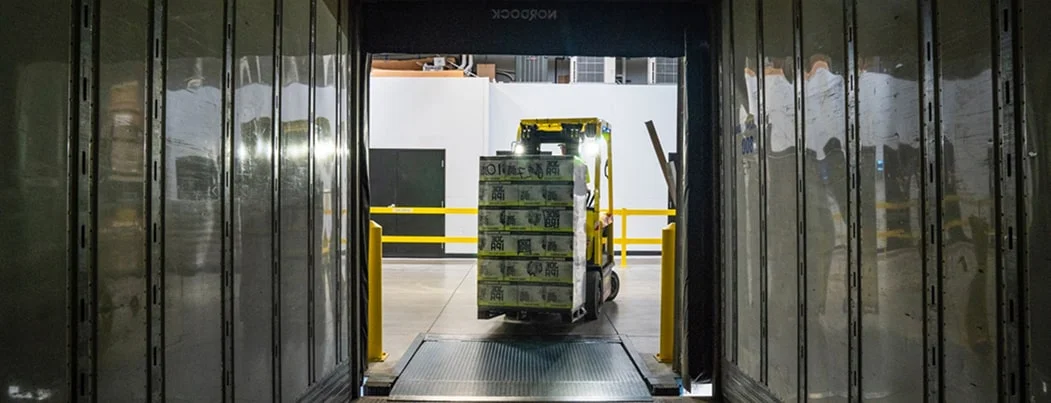
Management by exception software in logistics: requirements and must-have functionality
The world of logistics makes international trade run like clockwork, linking manufacturers and suppliers with consumers through global supply chains. This complex mechanism has many gears and pulleys that must be connected and work in tandem to move freights smoothly from start to finish.
But supply chains can slow down or grind to a halt when exceptions occur. Exceptional situations may include unavailability of raw materials, transport delays, adverse weather conditions, and personnel and procurement problems. To handle abnormal events, logistics business owners strive for flexibility in supply chain management software.
But how can you achieve flexibility in your supply chain and protect your business from the devastating consequences of unexpected situations? In this post, you’ll find out what management by exception is, how to practice it using software, and what benefits your business will get by developing a technical solution.


What is management by exception?
Management by exception is a process for dealing with situations that don’t fall under the standard processing algorithms during a typical workflow. These situations can be completely unforeseen (a fire in a warehouse), quite predictable (seasonal weather events), or common (vehicle breakdowns during delivery). But they all deviate from the ideal and cause headaches for logistics providers. Management by exception functionality aims to help logistics companies respond to such abnormal situations by automating supply chain processes.
By creating a technical solution for management by exception, your business may get the following benefits:
Increased productivity
Typically, to resolve exceptions, managers manually handle each case. Moreover, coping with a problem may require the participation of many workers. For example, without a clear plan of action in the event of a raw materials delay, the production manager will have to call the warehouse manager or the transport company manager to identify the cause of the delay.
Dealing with issues in this way is time-consuming and labor-intensive, which slows down the efficiency of the supply chain. Exception management software allows you to automate decision-making to resolve issues, thereby increasing your workflow efficiency.
For instance, following the introduction of new enterprise resource planning (ERP) solutions with exception management capabilities, Raytheon reduced manual handling of abnormal situations and allowed managers to focus on high-priority tasks such as communicating with customers. This approach helped the company increase the number of shipments by 10 percent per year, which positively affected its income.
Proactive solutions
As a rule, management by exception software processes data in real time and can compile statistics on each exception. With this data, you can identify when deviations happen most frequently and configure the system so that when common scenarios occur, it will alert managers with predefined options to resolve them.
Identification of bottlenecks within logistics processes
With the help of automated reports, exception management software can also help you identify why deviations most often occur. Imagine you find that exceptions occur most often due to delays in the delivery of raw materials. Based on this data, you can tighten your on-time delivery requirements by narrowing delivery windows and increasing penalties for non-compliance. Thus, you can improve fulfillment requirements by increasing partners’ responsibilities.
Now that you have a clear understanding of what exception management in logistics is and what benefits it offers, let’s discover how to define software requirements and understand what events your exception management system should cover for your business.
Steps to determine the requirements for your exception management software
A couple of years ago, the KFC restaurant chain faced a crisis due to a supply chain disruption in the UK and Ireland. After starting to work with a new logistics partner (DHL), KFC didn’t obtain a shipment of fresh chicken on time. The supply disruption forced KFC to close two-thirds of its restaurants in the UK and Ireland. The delivery failure was caused by a seven-vehicle collision on a highway. DHL trucks got stuck in traffic as soon as they left the warehouse, causing delays that led to a shortage of chicken at KFC restaurants.
Later on, logistics experts identified that KFC had just one warehouse for storing chicken. This and a lack of effective algorithms to overcome shipping exceptions were KFC’s fatal mistakes. When deciding whether to create your own software or use off-the-shelf software to manage exceptional events, first determine what events within your supply chain management platform should be automated. The following steps will help you determine your software’s functionality requirements, letting you cope with exceptional cases.
Step #1. Describe your ideal operations
The first step towards defining your system’s requirements is describing current and ideal workflows. This will allow you to identify gaps where failures may occur and will serve as the basis for future exception management software.
Let’s explore how you can describe your current processes and identify ideal scenarios using a basic example of transportation logistics. Imagine that the actual cargo delivery process looks as follows.
Drivers:
- Leave point A (depot)
- Pick up cargo from point B (warehouse)
- Deliver cargo to point C (first discharge point)
- Return to point B (the warehouse) to pick up the next cargo
- Deliver that cargo to point D (the second dispatch point)
By analyzing this process, you can detect any gaps in route planning and optimize the route.
By optimizing route planning, you’ll come up with a different ideal scenario.
Drivers:
- Leave point A (depot)
- Pick up cargo from point B (warehouse)
- Deliver the cargo to all points (C, D, etc.) along the route
- Return to point A (the depot)
Based on this example, you can document all your current processes, analyze logistics exception gaps, and build ideal scenarios.
Step #2. Define possible deviations
Knowing your business better than anybody else, you can determine when and where exceptions may occur. However, by looking at your processes in a new way, you can identify deviations that weren’t so obvious before. To do this, we suggest you look at the list of all operational processes you compiled earlier and write down the spots where disruptions can happen.
When delivering goods, the following deviations may occur:
- Absence of an administrator in dispatch locations
- Vehicle breakdowns
- Human factor-like drivers’ health issues
- Accidents or heavy traffic
Deviations vary depending on the field of activity in which your business is engaged. Document them all and move on to the next step.
Step #3. Describe established solutions to exceptions
The next step we advise you to take is writing down how you currently handle abnormal events. Take delivery delays caused by heavy traffic, for example. As a rule, a driver calls or texts a manager to inform them about the delay. In such a case, the manager may either tell the driver to continue the planned route despite the delays or reroute shipments and skip some delivery points, transferring them to the next trip.
Step #4. Determine what exceptions you can digitalize
After completing all the above steps, you’ll get a picture of how effectively you cope with exceptions and which cases can be automated. Note that you can handle some exceptional situations by adding extra features to your existing software.
Let’s imagine your warehouse gets a request to pack goods into cold chain packaging. But the manager discovers there isn’t enough staff to complete this task.
To avoid such a problem in the future, you can improve your existing warehouse management system (WMS) by adding a value-added services module. Value-added functionality may allow you to automatically select, place, and track shipments for additional services and make ready tools and personnel for their fulfillment. If you want to improve your warehouse processes, check out our article on how to build an effective WMS.
Step #5. Determine functions to cope with exceptions
At this stage, you need to determine how and with what logistics tools you would like to cope with deviations. For example, say you need to reduce the time spent transferring data about failures to timely inform other supply chain participants about them. In this case, your management by exception software must let you transfer data in real-time. Or perhaps you need to improve communication between drivers and managers via instant notifications and real-time messaging.
We advise you to analyze each exception and decide what tools you need to add to your software to respond to it. These requirements will lay the foundation for your exception management system.
After going through all these steps, you’ll get a kind of checklist with requirements. This list can help you determine if ready-made solutions meet your business needs or if you need to develop custom software.
What are the components of a great exception management solution?
A requirements document that lists all functions by importance makes your decision-making much easier. But any exception management system must satisfy several basic requirements that will simplify the process of resolving deviations.
Automated exception handling
Automation means minimized human participation and the ability of the system to independently decide how to handle exceptions. That’s when algorithms come into play. An algorithm is a sequence of well-defined actions that resolve a problem. The usual scenario you follow when manually solving exceptions can be transferred into algorithms and adopted by your system.
But there are also ready-made solutions that may meet your requirements. For example, the technology company Predata uses a machine learning algorithm to help customers respond to abnormal situations associated with geopolitical and market changes (machine learning business use cases). The system automatically receives data from social networks, news agencies, and other sources. Using a machine learning algorithm, it then analyzes this data and automatically reconfigures the workflow taking into account all the peculiarities.

Creating algorithms is time-consuming and costly. That’s why we usually use ready-made solutions to save our clients’ budgets and provide faster development. However, it’s worth remembering that implementing algorithms into a system is also a complex process that requires the participation of an experienced development team.
Notification system
Make sure your software has a well-functioning notification system. This is necessary so managers are aware of disruptions that have occurred, can react to them in time, and can effectively resolve them. To inform managers in a timely manner, the system can send automatic notifications via SMS, email, or push notifications triggered by the issue status. In one of our previous articles, we talked about how you can implement push notifications in your mobile application.
You also can take a look at how we implemented notifications in a transportation management system (TMS). This TMS has a notification function to deal with delivery delays. For example, when a driver arrives at a location at the agreed time and finds the customer is absent, it’s the driver’s job to take the appropriate action. Using an app, the driver can select an issue from a dropdown list and automatically send a notification to the manager who needs to resolve it.
The TMS automatically serves the request, and the manager receives a notification offering two options: wait for the customer or skip the delivery point. By assessing the exception and all risks associated with it, the manager can make the optimal decision to minimize damage to the business. If the manager selects to skip the delivery point, the driver receives a notification of this decision and the TMS automatically redesigns the route with the warehouse as the endpoint.
Real-time data analytics
The main reason for exceptional events is a lack of information. An exception management system should give you the ability to centrally manage all data and receive accurate and up-to-date information about the performance of suppliers, customers, personnel, and equipment. Moreover, the system must allow you to analyze and exchange data in real time with other enterprise systems in the supply chain. These systems gain advanced capabilities and intelligence through the use of AI development services, enabling more precise analytics and streamlined automation.
In order to implement real-time data exchange and analysis in your software, your TMS needs to ensure the smooth collection of data from your customers, suppliers, transport operators, warehouses, financial systems, and custom portals. For collecting data in real time most often uses a crawler, scheduler, and event sourcing.
A crawler allows software to automatically search for information across all systems in your supply chain. With a scheduler, you can configure the periods in which the crawler will request information from systems. Event sourcing allows the system to log every change in events. Using these tools, you get the ability to automatically analyze large data flows and make data-driven decisions.

Analyzing big data in real-time involves sending data to a server as soon as your system submits it. For example, you can set up automated analytics for reports received from raw material suppliers or a transport company you work with. With the help of a scheduler, a crawler can request data at set times from other enterprise modules (for example, a WMS or TMS) and commit this data to the database.
Event sourcing automatically updates data and provides a consistent view of updated events across the supply chain. You can learn more about exchanging and processing data in real time from our article.
Real-time data monitoring and processing allows you to analyze reports, identify where and why exceptions occur most often, and change your decision-making algorithm. Also, using reports, you may find events that can be eliminated and will no longer be exceptions. Suppose you detect that delivery delays occur due to frequent breakdowns of equipment during cargo loading. You can recheck your equipment, and if it’s out of order, you can replace it with new equipment. New loading equipment can help you reduce recurring incidents or eliminate exceptions.
Predicting deviations
Just as exception management software helps you make context-based decisions to eliminate the risk of disruptions, it must also be able to anticipate potential problems. For example, if your transport company is in an area at increased risk of tornadoes or storms, you need to consider a solution that can warn about devastating weather conditions.
As a rule, artificial intelligence (AI) is used in software to solve such problems. In their review of supply chain trends, Gartner called AI a technology that is constantly changing and has great potential in the supply chain.
Artificial intelligence is capable of doing things that humans simply cannot do – or at least cannot do as efficiently. For example, AI can help you collect and evaluate huge volumes of disparate data that’s often changing at lightning speed. Also, it can provide actionable analytics that give managers a deeper understanding of situations and the ability to make decisions with less risk to the business.
Riskpulse is a platform that can integrate with your TMS for exception management, analyzing data, and sending alert messages. Using AI algorithms, the program assesses the risk of bad weather on a scale from 1 to 25 and constantly updates the data. In case it detects adverse weather conditions, the system sends a notification to the manager, allowing them to take appropriate action.

Exceptions that aren’t properly addressed can have far-reaching implications across the entire supply chain. Therefore, in order to effectively deal with them, the functions are combined, creating a complex solution for managing exceptions.
Why you should develop a custom exception management solution
Although there are many ready-made deviation management solutions on the market, they might be fraught with the problems we explore below. In the long run, developing a custom solution will be more beneficial. Here’s why:
Standard functionality might not meet your business needs. Most third-party exception management solutions provide standard functionality. But each business is unique, and there’s a possibility that standard feature sets won’t cover all your business needs. When developing a custom product, our specialists first analyze your established workflow in detail. Based on the data obtained, we develop a solution adapted to the needs of your business.
Inconsistency of the technology stack. Imagine you’ve found a function set suitable for your operations. However, when you decide to add it to your licensed software, you discover that the technology stack isn’t interoperable. When developing a management by exception module from scratch, our development team studies your existing system and identifies the most suitable tech stack.
Usability obstacles. Often, to ensure smooth supply chain operations, logistics business owners decide to integrate several diverse modules and function sets. But this approach may lead to poor usability and a high risk of human errors. To avoid this, we study your software and develop an exception management module with a familiar interface for faster and easier onboarding.
The supply chain is a complex mechanism that is subject to many risks. But technologies and software don’t stand still, and they can help you effectively manage deviations. Yalantis has extensive experience developing logistics platforms and can help you automate all your supply chain processes. If you still have questions, drop us a line to discuss your business problem.
Want to boost your supply chain processes?
Learn more about our logistics software development services.
Let us introduce ourselvesRate this article
4.1/5.0
based on 34 reviews





